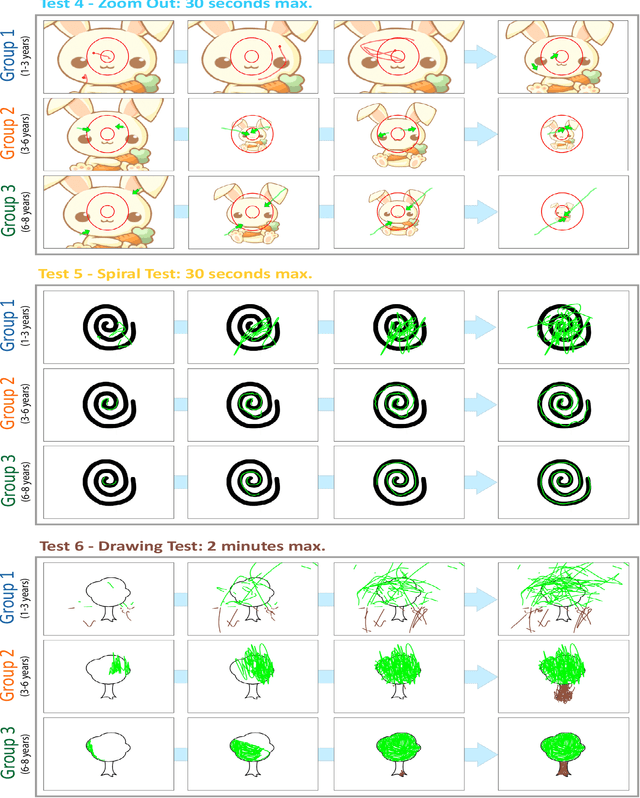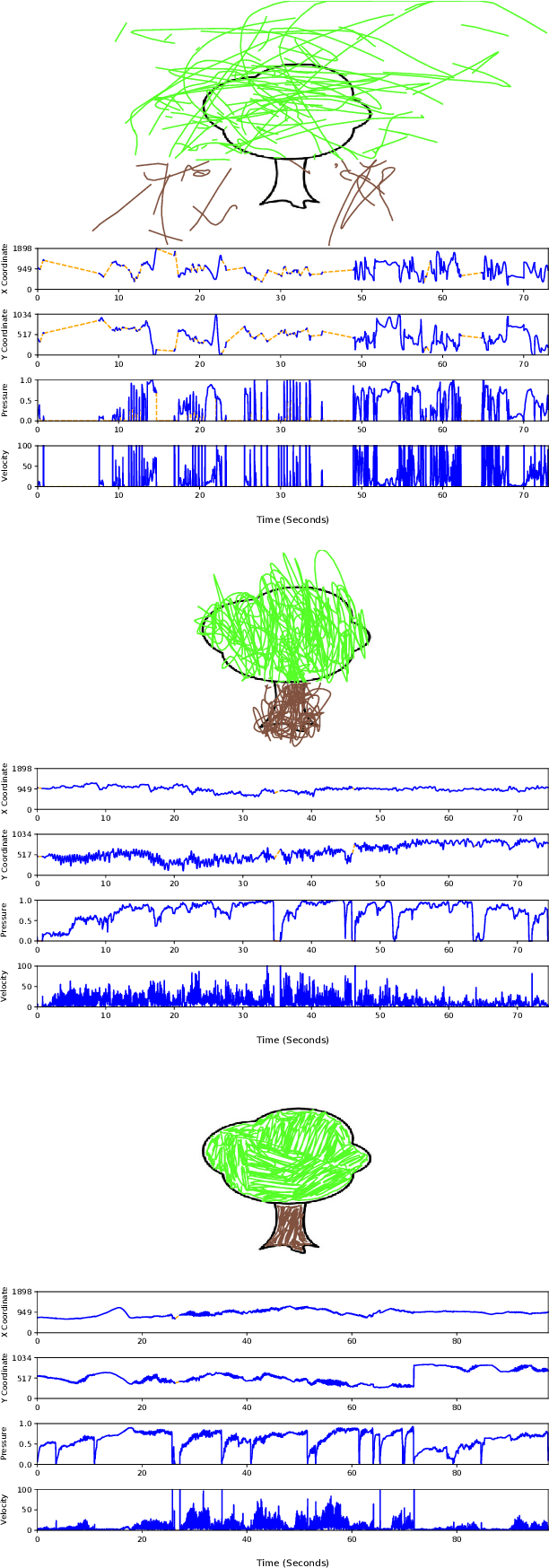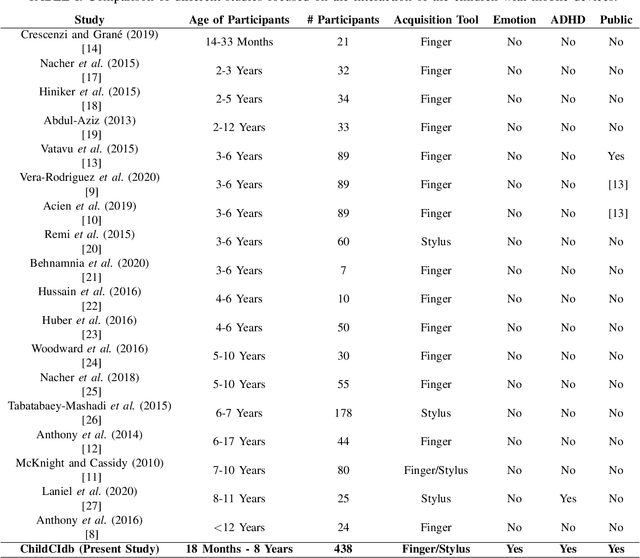Juan Carlos Ruiz-Garcia
CareFall: Automatic Fall Detection through Wearable Devices and AI Methods
Jul 11, 2023Abstract:The aging population has led to a growing number of falls in our society, affecting global public health worldwide. This paper presents CareFall, an automatic Fall Detection System (FDS) based on wearable devices and Artificial Intelligence (AI) methods. CareFall considers the accelerometer and gyroscope time signals extracted from a smartwatch. Two different approaches are used for feature extraction and classification: i) threshold-based, and ii) machine learning-based. Experimental results on two public databases show that the machine learning-based approach, which combines accelerometer and gyroscope information, outperforms the threshold-based approach in terms of accuracy, sensitivity, and specificity. This research contributes to the design of smart and user-friendly solutions to mitigate the negative consequences of falls among older people.
ChildCI Framework: Analysis of Motor and Cognitive Development in Children-Computer Interaction for Age Detection
Apr 08, 2022



Abstract:This article presents a comprehensive analysis of the different tests proposed in the recent ChildCI framework, proving its potential for generating a better understanding of children's neuromotor and cognitive development along time, as well as their possible application in other research areas such as e-Health and e-Learning. In particular, we propose a set of over 100 global features related to motor and cognitive aspects of the children interaction with mobile devices, some of them collected and adapted from the literature. Furthermore, we analyse the robustness and discriminative power of the proposed feature set including experimental results for the task of children age group detection based on their motor and cognitive behaviors. Two different scenarios are considered in this study: i) single-test scenario, and ii) multiple-test scenario. Results over 93% accuracy are achieved using the publicly available ChildCIdb_v1 database (over 400 children from 18 months to 8 years old), proving the high correlation of children's age with the way they interact with mobile devices.
SVC-onGoing: Signature Verification Competition
Aug 13, 2021



Abstract:This article presents SVC-onGoing, an on-going competition for on-line signature verification where researchers can easily benchmark their systems against the state of the art in an open common platform using large-scale public databases, such as DeepSignDB and SVC2021_EvalDB, and standard experimental protocols. SVC-onGoing is based on the ICDAR 2021 Competition on On-Line Signature Verification (SVC 2021), which has been extended to allow participants anytime. The goal of SVC-onGoing is to evaluate the limits of on-line signature verification systems on popular scenarios (office/mobile) and writing inputs (stylus/finger) through large-scale public databases. Three different tasks are considered in the competition, simulating realistic scenarios as both random and skilled forgeries are simultaneously considered on each task. The results obtained in SVC-onGoing prove the high potential of deep learning methods in comparison with traditional methods. In particular, the best signature verification system has obtained Equal Error Rate (EER) values of 3.33% (Task 1), 7.41% (Task 2), and 6.04% (Task 3). Future studies in the field should be oriented to improve the performance of signature verification systems on the challenging mobile scenarios of SVC-onGoing in which several mobile devices and the finger are used during the signature acquisition.
ICDAR 2021 Competition on On-Line Signature Verification
Jun 01, 2021

Abstract:This paper describes the experimental framework and results of the ICDAR 2021 Competition on On-Line Signature Verification (SVC 2021). The goal of SVC 2021 is to evaluate the limits of on-line signature verification systems on popular scenarios (office/mobile) and writing inputs (stylus/finger) through large-scale public databases. Three different tasks are considered in the competition, simulating realistic scenarios as both random and skilled forgeries are simultaneously considered on each task. The results obtained in SVC 2021 prove the high potential of deep learning methods. In particular, the best on-line signature verification system of SVC 2021 obtained Equal Error Rate (EER) values of 3.33% (Task 1), 7.41% (Task 2), and 6.04% (Task 3). SVC 2021 will be established as an on-going competition, where researchers can easily benchmark their systems against the state of the art in an open common platform using large-scale public databases such as DeepSignDB and SVC2021_EvalDB, and standard experimental protocols.
Child-Computer Interaction: Recent Works, New Dataset, and Age Detection
Feb 02, 2021



Abstract:We overview recent research in Child-Computer Interaction and describe our framework ChildCI intended for: i) generating a better understanding of the cognitive and neuromotor development of children while interacting with mobile devices, and ii) enabling new applications in e-learning and e-health, among others. Our framework includes a new mobile application, specific data acquisition protocols, and a first release of the ChildCI dataset (ChildCIdb v1), which is planned to be extended yearly to enable longitudinal studies. In our framework children interact with a tablet device, using both a pen stylus and the finger, performing different tasks that require different levels of neuromotor and cognitive skills. ChildCIdb comprises more than 400 children from 18 months to 8 years old, considering therefore the first three development stages of the Piaget's theory. In addition, and as a demonstration of the potential of the ChildCI framework, we include experimental results for one of the many applications enabled by ChildCIdb: children age detection based on device interaction. Different machine learning approaches are evaluated, proposing a new set of 34 global features to automatically detect age groups, achieving accuracy results over 90% and interesting findings in terms of the type of features more useful for this task.
 Add to Chrome
Add to Chrome Add to Firefox
Add to Firefox Add to Edge
Add to Edge